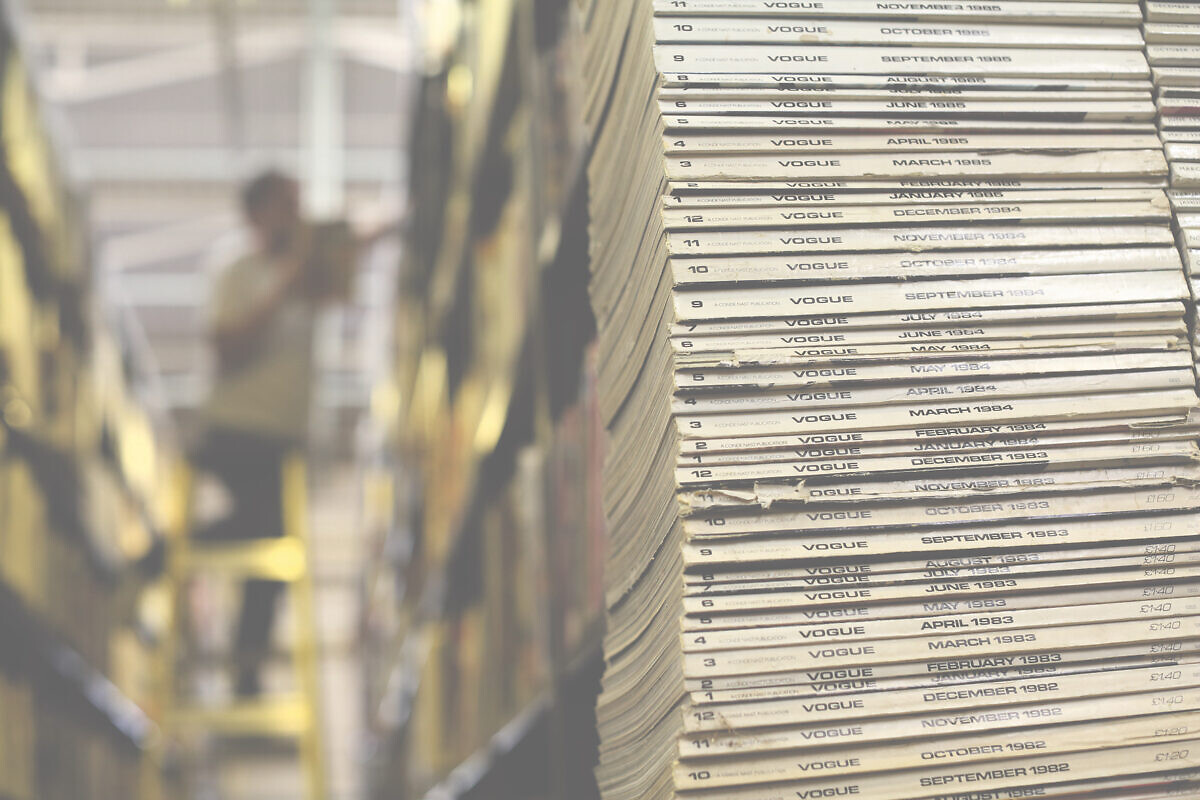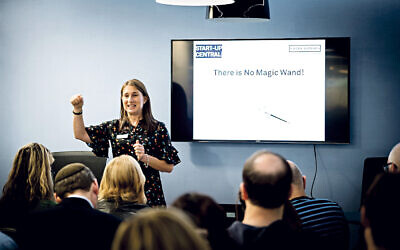This man wants to save our history
James Hyman has the world's largest magazine collection and it needs a museum to preserve our past and inform our future.
Look at this. Just look at this!” Balancing precariously at the top of a ladder, James Hyman lurches forward, waving a copy of Omni, a little-known American sci-fi magazine that stopped publishing in 1995. “This issue is from 1983, just look at the coverline,” gushes James as he reads aloud the tag.
“It’s incredible how computers are becoming as sophisticated as humans. Forty year-old content predicting the age we are living in. I find this stuff all the time. And every magazine, irrespective of whether it is Vogue, Playboy, The Sunday Times or New Scientist. reveals moments in history that present the future.”
James Hyman is a magazine fiend. He has tens of thousands of them – and his archive, HYMAG, has been officially confirmed as the largest collection in the Guinness World Records. But that was back in 2012, when he had 53,012 magazines and was suitably chuffed to be recognised. Now, as he points out, “it’s probably one of the only Guinness records, apart from growing your nails, that you beat every day, because I kept on acquiring them”. Until recently the archive was stacked, piled and catalogued on to more than 3,000 feet of shelving inside a former cannon foundry in Woolwich.
Get The Jewish News Daily Edition by email and never miss our top stories Free Sign Up

The historic space was a fitting resting place for such print beauties as the first edition of Tatler (1901) Kate Moss’s first cover (The Face 1990) and a copy of John O London’s Weekly from 1938 with a front-page story about the future of the Jews. To single out one or two from the multitude runs the risk of insulting James’ efforts as a collector, for the archive is a labour of love and an invitation to see, smell and touch them is a privilege for anyone who truly loves magazines.
Raised in St John’s Wood, James was a pupil at St Paul’s and soon moved on from collecting The Beano, The Dandy and Mad as a kid, to Rolling Stone, Empire and Smash Hits as a teenager, all of which he never threw away. He intended to study Latin at Manchester, but a summer job in MTV Europe’s press office proved too enjoyable to give up. So he stayed and did a media and film degree at London’s Guildhall University on the side to keep his parents happy (securing a first BA Hons).

Post-degree, he became a broadcaster, TV and film music supervisor, then a DJ on XFM for seven years, but his penchant for periodicals constantly proved an asset when he was a script writer preparing research for bigname interviews. “I had to constantly write these soundbites for presenters and, rather than have them saying something banal about Madonna or ask David Bowie or George Michael about their favourite colour, I gathered solid information from four-page features in Rolling Stone or NME and fished out the good quotes,” says James, who worked on a ‘buy a mag for work and one for me’ principle, inevitably keeping them both.
“I was looking at NMEs in the archive only the other day and the detail of the interviews and features… well, they’re diaries documenting the period. There’s so much meat, it’s like the Midrash.”
An odd comparison, but not for James who, since losing his photographer father Basil three years ago, has become more observant. This life change has also reignited his appreciation for the other part of his collection – the library of more than six million press cuttings that he inherited from German archivist Edda Tasiemka who, together with her husband Hans, provided essential research for London’s journalists for many years.

Edda who died in 2019, was 95 and still working when she gifted the archive to James, after Robert Maxwell and Eddie Shah had offered her millions to buy it. James loved her and admired her so much; he includes her in his “thanks to Hashem”. James’ parents and the various friends he lived with were less appreciative of his ever-burgeoning magazine collection, which took a toll on all their floorboards – “they cracked” – eventually forcing him to put everything in storage in the early 90s.
And there it remained until 2011, when he was introduced to curator Tory Turk, who had worked for Somerset House, The V&A and such, and she helped him to first catalogue his vast CD collection and then start on the 300 crates of magazines. “I hadn’t seen them for 25 years, so I was terrified they might have been water-damaged or bug-infested, but amazingly, only one crate was slightly affected.”

It took a year to archive the magazines, during which time they moved premises, but wherever James landed there was a demand for HYMAG’s services. “The Guinness record also attracted an investor who saw the commercial value in the rich content,” he explains. “And that is ultimately what this is all about – content. What I have is an untapped valuable resource. Hundreds of stylists, designers, writers, broadcasters, universities, law firms and media agencies contact us for their projects.”
James cites a few, among them such specific requests as the ad agency looking for a celeb casually wearing Fred Perry. “Because the archive isn’t fully digitised, Tory and I had to go through every single NME from the 60s to the present day, praying there would be someone on the cover wearing Fred Perry, and lo and behold, that someone was Blur’s Damon Albarn looking casual at Glastonbury in 1997!” James and Tory also found rare requested 90s adverts for Nike from various publications, an obscure image of The Beatles for a film about them and a crime case that was only documented in GQ.

“There is no such thing as a ‘typical’ request, as we discovered when a student needed our help for her dissertation on architecture featured in Playboy! The ‘bachelor pad’ was coined by the mag apparently.” The myth about Google having all the answers accounts for HYMAG’s many requests from people willing to pay the hourly rate for access and assistance. But instead of expanding due to demand, HYMAG has left the building. The Royal Arsenal complex in Woolwich is no longer home; in fact, the collection is homeless ’ and back in crates.
“Storage costs are astronomical and, with so many enquiries, we need a lot more staff,” admits James, who has added his company to his prayers. “I know I’m blessed with two children and an understanding wife, but I can’t give up on this because I know if we could continue to digitise it, scale up and make it available to more people, it would become a utility like the British Library, but far more accessible. “We have already begun the process, securing exclusive digital rights to such style bibles as The Face and i-D. The knowledge potential in the age of AI [and] ChatGPT is phenomenal.”

A museum dedicated to magazines that are also available physically is James’ dream, and one that will benefit school and university students who will learn from history. “Did you know there is scientific proof that you learn more reading a newspaper, magazine or book than staring at a screen?” he says. “Not that one is better than the other as they go hand in hand. They are symbiotic. My mantra for HYMAG is ‘physical, digital, spiritual.’” Smiling and tentatively optimistic about HYMAG’s future, he climbs the ladder to empty another shelf.
“Look at this,” he shouts picking up a 1991 copy of Vanity Fair with Streisand on the cover. “Isn’t it wonderful?” ‘Discover, Trust, Protect and Preserve’ are the words on HYMAG’s business card and they don’t need explaining to anyone who loves magazines and understands how we need to save published history to inform our future. Take a look at the website and marvel. James is open to offers that will enable us to leave a print legacy for future generations. https://hymag.com/

Thank you for helping to make Jewish News the leading source of news and opinion for the UK Jewish community. Today we're asking for your invaluable help to continue putting our community first in everything we do.
For as little as £5 a month you can help sustain the vital work we do in celebrating and standing up for Jewish life in Britain.
Jewish News holds our community together and keeps us connected. Like a synagogue, it’s where people turn to feel part of something bigger. It also proudly shows the rest of Britain the vibrancy and rich culture of modern Jewish life.
You can make a quick and easy one-off or monthly contribution of £5, £10, £20 or any other sum you’re comfortable with.
100% of your donation will help us continue celebrating our community, in all its dynamic diversity...
Engaging
Being a community platform means so much more than producing a newspaper and website. One of our proudest roles is media partnering with our invaluable charities to amplify the outstanding work they do to help us all.
Celebrating
There’s no shortage of oys in the world but Jewish News takes every opportunity to celebrate the joys too, through projects like Night of Heroes, 40 Under 40 and other compelling countdowns that make the community kvell with pride.
Pioneering
In the first collaboration between media outlets from different faiths, Jewish News worked with British Muslim TV and Church Times to produce a list of young activists leading the way on interfaith understanding.
Campaigning
Royal Mail issued a stamp honouring Holocaust hero Sir Nicholas Winton after a Jewish News campaign attracted more than 100,000 backers. Jewish Newsalso produces special editions of the paper highlighting pressing issues including mental health and Holocaust remembrance.
Easy access
In an age when news is readily accessible, Jewish News provides high-quality content free online and offline, removing any financial barriers to connecting people.
Voice of our community to wider society
The Jewish News team regularly appears on TV, radio and on the pages of the national press to comment on stories about the Jewish community. Easy access to the paper on the streets of London also means Jewish News provides an invaluable window into the community for the country at large.
We hope you agree all this is worth preserving.
-
By Brigit Grant
-
By Laurent Vaughan - Senior Associate (Bishop & Sewell Solicitors)
-
By Laurent Vaughan - Senior Associate (Bishop & Sewell Solicitors)
-
By Laurent Vaughan - Senior Associate (Bishop & Sewell Solicitors)
-
By Laurent Vaughan - Senior Associate (Bishop & Sewell Solicitors)






















